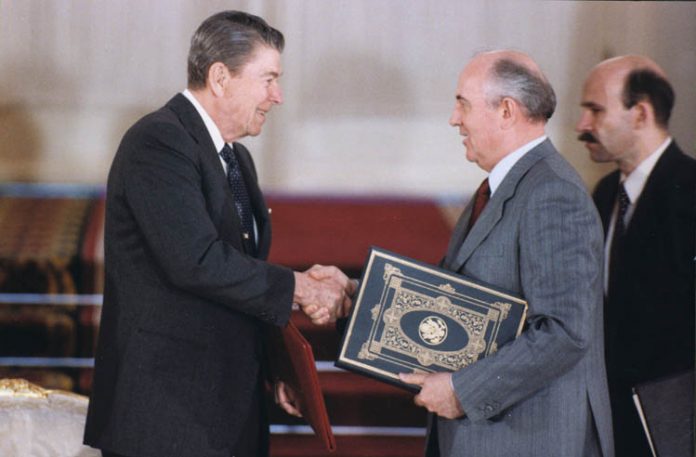After almost 32 years since the United States of America and the Union of Soviet Socialist Republics entered into a treaty to eliminate their Intermediate-Range and Short-Range Missiles, the Trump administration has withdrawn from the Intermediate-Range Nuclear Forces Treaty. The move by the Trump administration begs the question regarding the fate of the global nuclear non-proliferation regime.
Proponents of nuclear weapons disarmament are still trying to figure out how the withdrawal from a treaty that was very significant in facilitating the elimination of nuclear and conventional ground-launched ballistic and cruise missiles with ranges of 500 to 5,500 kilometers is in the best interests of curbing nuclear proliferation or America’s foreign policy. At a time when North Korea’s nuclear program is being labelled as a threat to non-proliferation, the Trump administration’s move creates more questions than answers. Arguably, the withdrawal has created a vacuum for both rogue nuclear states and existing nuclear powers to continue proliferation activities which could only lead to a nuclear arms race in the 21st century.
At this stage, Russia would benefit largely from the US withdrawal because it has been covertly developing and deploying intermediate-range missiles when the treaty was still in effect. However, this does not mean that the United States should dissolve the whole treaty. The Trump administration, together with Western allies, could have put measures in place to ensure that Russia would comply with the INF treaty instead of giving Putin a gift to overtly develop and deploy the intermediate-range nuclear missiles. Some might argue that there wasn’t anything further than the INF treaty that the Trump administration could have enforced to dissuade Putin’s covert missile program. But there is a reason to believe that the US and its allies could have used targeted economic sanctions or diplomacy to persuade Russia to comply instead of the misguided withdrawal from the treaty.
Even though there was a dialogue between Russian and US officials in January 2019 to try to save the INF treaty, the discussion ended in a deadlock. Because Russian diplomats proposed that Russia should display the 9M729 missile and demonstrate that it could not fly to INF range, while the United States, in exchange, should demonstrate that the MK-41 launchers in Romania could not be converted to launch INF-range cruise missiles. Deadlocks are prevalent in diplomatic negotiations but there are ways for diplomatic practitioners to break them, for instance, through concessions or waiting for ripe moments to engage with the other party. In this case, the diplomatic officials from both sides may have an advantage because they already had a treaty in effect and they were not soliciting a new treaty. What’s needed from both sides might be patience in opening more channels for diplomatic talks that would save the treaty that came about as a result of the 1979 “dual-track” decision.
Scenario planning might have been conducted to some extent by the Trump administration in 2017 on how to respond to Russia’s covert missile program. But the administration’s hasty decision to withdraw from the INF treaty does not show that they had fully weighed both the pros and the cons of such a decision. As is mentioned above, their decision serves Russian interests more than that of the United States. Therefore, the scenario planners did not take into account the specific detriments to the global non-proliferation regime the withdrawal would have. Even though there have been concerns over Russia’s compliance with the INF Treaty since 2013, the scenario planners should have asked themselves how they could continue to persuade Putin to comply with the INF Treaty. Based on the Trump administration’s ignorance when it comes to foreign policy decisions and goals, it is questionable whether they anticipated the consequences of their decision.
The withdrawal from the INF treaty is a threat to the current international system and represents a potential security breach in Western Europe. Not only has the security of Europe been compromised but America’s relations with its Western European allies have entered another phase of unwanted strains. Unpredictability and the danger within the European theatre will increase because Russia can now throw around more missiles and weapons of all kinds, but particularly nuclear ones. This means the North Atlantic Treaty Organization (NATO) has much to lose from the suspension than Russia. Before, the suspension was made into policy the Trump foreign policy team should have asked itself who had more to benefit from a suspension of compliance than the party who has been violating the terms of the INF in the first place. Unlike the Cold War period when the Western allies allowed the US to deploy nuclear weapons in Europe, in this current climate where Trump has done all he can to burn bridges with Washington’s European allies, the US may forget using Europe to counter Russia’s nuclear arsenal.
However, the US still maintains at least 180 tactical nuclear weapons at bomber bases in five European countries which could still be used as a deterrence to Russia’s nuclear program. Considering that the US has not been developing any new nuclear warheads in the past years, the current bomber bases in Europe might again become very significant as a potential arms race looms on the horizon. Even though Russia has been covertly going against the INF treaty, its nuclear arsenal still pales in comparison to that of the US in terms of quality. Meanwhile, the current US financial investment in nuclear forces is unrivaled by any other nuclear power.
On the other hand, China, a non-signatory to the INF treaty has been upgrading its nuclear arsenals, which presents a challenge to the US dominance in Asia (China’s nuclear stockpile is below 300, compared to nearly 7,000 and 6,500 Russian and US warheads, respectively). Some pundits have argued that the challenge from China’s development of missile delivery systems to the US in the Pacific region could be the reason why the Trump administration suspended compliance with the INF treaty. Even though this might have been one of the motivating factors, there is still room to argue that the INF treaty did not have to be dissolved but China could have been invited to join the treaty as a signatory.
Instead of dissolving treaties that curb nuclear arms races, it is time for the international community to extend arms control participation. If China, Russia, the United States, and other small nuclear powers participate in arms control, the chances of an increased security dilemma become less. The Trump administration has opened the doors for an arms race that may bring back the ghosts of the Cold War, even though the administration’s intention was to make the US more secure. The collapse of the INF Treaty could compel China to institute counter-measures, such as rapidly expanding its warhead numbers. China’s response, in turn, may trigger re-adjustments to India’s doctrine of credible minimum deterrence and could produce matching re-adjustments by Pakistan. It is these events that would illustrate an ongoing security dilemma, and eventually lead to an arms race.
A Chinese nuclear expert Tong Zhao’s conclusion holds for the whole world, not just China: “… the era of relying on the US-Russia bilateral arms control structure is at its end”. Nuclear non-proliferation should no longer be constituted based on US-Russia dynamics but should be discussed on a multilateral basis to prevent legal and rogue nuclear states from making the presumption that they can proliferate without proper protocols in place. In a multilateral arms control setting, the US and Russia would no longer jointly decide what the fate of the global non-proliferation would be.
The views and opinions expressed in this article are those of the author and do not necessarily reflect the official policy or position of The Geopolitics.
 This work is licensed under a Creative Commons Attribution-NonCommercial-NoDerivatives 4.0 International License.
This work is licensed under a Creative Commons Attribution-NonCommercial-NoDerivatives 4.0 International License.

Ian Fleming has an M.A. & B. A. in International Politics by the University of South Africa. He has been published in Asian Journal of Peace. His areas of research include nuclear diplomacy, cybersecurity, and foreign policy. He is currently serving as the Editor in Chief for IAPSS journal ADV and is the Chairperson of the IAPSS SRC on Conflict Security & Crime. Furthermore, he is a member of the Comprehensive Nuclear Test Ban Treaty Organization Youth Group. In addition, he is a board member of the British American Security Information Council’s Emerging Voices Network.


